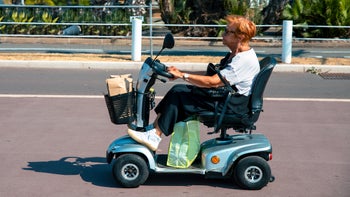Does Medicare Cover Wheelchairs?
Key takeaways:
Medicare Part B and Medicare Advantage plans cover manual and power wheelchairs under certain conditions.
To have your wheelchair approved, the device must be needed inside the home. You must also meet other conditions, including having limited mobility or a qualifying disability and a documented medical need for the wheelchair.
Having Medicare does not guarantee approval for your wheelchair, but you can appeal a denied claim.
Table of contents

About 5.5 to 6 million people in the U.S. — more than 2% of the nation’s adults — use wheelchairs. Individuals ages 65 and older are four times more likely to use a wheelchair than adults who are younger.
Medicare, the federal health insurance program for adults ages 65 and older and younger people with certain disabilities, covers manual and power wheelchairs (and power scooters) for people who need these assistive devices for use in their home. Here’s what you need to know to get Medicare coverage for a wheelchair.
Will Medicare cover my wheelchair?
As long as you meet eligibility requirements, Medicare Part B or Medicare Advantage will cover your wheelchair. Qualifying for coverage for this type of durable medical equipment (DME) will depend on several factors, including:
The type of wheelchair requested, such as a manual or power wheelchair or a power scooter
Your diagnosis
Your need for the wheelchair to get around your home
Save on more than prescriptions
Unlock exclusive offers from our partners

Medicare Part B requirements for wheelchair coverage
Medicare Part B is medical coverage for outpatient care and DME such as wheelchairs. To be covered through Part B, your wheelchair must be prescribed for use in your home. Also, your prescriber and DME supplier must be enrolled in Medicare. And you must get an in-person exam and a prescription from a healthcare professional.
The face-to-face visit for a manual wheelchair should be no more than 6 months before your prescription is written. For a power wheelchair, your in-person appointment should be no more than 45 days before the prescription is written. Medicare will cover only one type of mobility aid for use at home.
Types of wheelchairs Medicare covers
Medicare covers a variety of wheelchairs. The three main types are:
Manual wheelchairs
Power wheelchairs
Power scooters
Wheelchair accessories
Your wheelchair will come with a basic package that is appropriate for you. For instance, your chair may come with a larger, nonstandard seat that fits you. If medically necessary, these options and accessories may be covered:
Arm rests
Batteries
Chargers
Head rests
Larger seats
Leg rests
Medicare wheelchair coverage
Many disabilities can affect mobility, but only people with certain conditions qualify for a Medicare-covered wheelchair or power chair. To get coverage, you need to be diagnosed with an illness or injury that causes limited mobility. You must also meet all of these criteria:
You have a condition that causes significant difficulty moving around at home.
You’re unable to perform daily activities, such as bathing, dressing, or using the bathroom, without a wheelchair. If you can accomplish these activities with a cane, crutch, or walker, you do not qualify.
You can safely get in and out of a wheelchair, or you have someone to help you use the device.
The healthcare professional treating you and your wheelchair supplier both accept Medicare.
Your healthcare professional or supplier has visited your home to verify that you can use a wheelchair or power scooter there.
Medicare covers durable medical equipment (DME). Many types of DME, including mobility aids, diabetes supplies, and respiratory equipment, are covered by original Medicare and Medicare Advantage.
What type of canes are covered by Medicare? Standard canes, quad canes, seat canes, and folding canes are among the stabilizing mobility sticks covered by Medicare.
Walkers with and without wheels are covered by Medicare. A standard pick-up walker is covered by Medicare, but so are rollators and other walkers with wheels.
How to get a wheelchair covered by Medicare
Here are some tips for getting Medicare to cover the wheelchair you need.
Meet with your healthcare professional
Your Medicare-enrolled healthcare professional should meet with you in person to assess your physical condition. If a wheelchair is medically necessary, they will write you a prescription stating you need the mobility aid at home and what type of wheelchair you need.
Check your plan details
Medicare Part B will cover 80% of your chair’s costs after you meet your deductible, which is $257 in 2025.
Read more like this
Explore these related articles, suggested for readers like you.
Your supplier may need to get prior authorization for a power wheelchair or scooter to be covered. (These are the types of power wheelchairs that require prior authorization.) Similar advance approval may be needed if you have a Medicare Advantage plan.
Evaluate your costs
In most cases, manual and power wheelchairs are rented for the first 13 months. If you’re renting your wheelchair, you will need to meet your deductible and then pay 20% coinsurance on the monthly rental fee during this period. After that, you will own the chair outright.
You must use a Medicare-enrolled supplier who agrees to “accept assignment” for your wheelchair order. If a supplier doesn’t participate in Medicare and can’t accept assignment, you could be charged the entire cost out of pocket.
If you have Medicare Advantage, you can find a description of your plan’s cost-sharing requirements by reviewing your evidence of coverage. Or you can contact your plan directly about wheelchair benefits.
Will I have to pay anything out of pocket?
With Medicare Part B, you will pay your deductible and then 20% of the remaining costs for a wheelchair. With Medicare Advantage, your benefits and out-of-pocket costs will depend on your plan.
How often can a Medicare enrollee get a wheelchair?
In general, you can get a Medicare-covered wheelchair once every 5 years. You may be able to get a replacement sooner if you have a special circumstance, such as loss, theft, or damage beyond repair from an accident or a natural disaster.
For a rented wheelchair that is less than 5 years old, Medicare Part B will cover repairs and maintenance up to the cost of a replacement. The supplier will pick up the rented equipment that’s in need of repair. And Medicare will cover the cost of loaned equipment while your chair is being fixed.
What to do if your claim is denied
If Medicare denies your claim for wheelchair coverage, file an appeal. The appeals process is different for Medicare Part B and Medicare Advantage.
DME loan programs
If you can’t get your wheelchair covered by Medicare, you’re waiting on prior authorization, or you have an ongoing appeal — and you need mobility assistance immediately — you may be able to find a free DME loan program near you.
Frequently asked questions
After a supplier submits a claim for your wheelchair, the request should be approved in 10 days or less, because the process requires prior authorization or a preclaim review decision. According to a January 2025 report from the Centers for Medicare & Medicaid Services, the average time for an original Medicare DME coverage request to be provisionally approved was 4.4 days during the 2022-2023 fiscal year. The current timeline may differ somewhat from this, whether you have an original Medicare or Medicare Advantage plan.
In addition to wheelchairs, Medicare covers many other types of mobility aids, including:
Medicare does not cover mobility items, such as stair lifts, that are considered home improvements.
As mentioned, Medicare will not pay for equipment that is deemed a home improvement, and this includes wheelchair ramps. Some Medicare Advantage plans may cover a wheelchair ramp.
Wheelchair costs vary based on the type of device and whether it’s new or pre-owned, as well as the options and accessories you need. A new standard or lightweight manual wheelchair, which you can buy from a retail pharmacy, can cost less than $200. Most new wheelchairs purchased from a DME supplier range from $500 to $1,500. A new high-end power wheelchair can cost $5,000 or more.
The bottom line
If you meet eligibility requirements, Medicare Part B or Medicare Advantage will cover your manual wheelchair, power wheelchair, or power scooter. If you have Medicare Part B, you must meet your deductible and then your plan will start sharing the costs. With Part B, you are responsible for 20% coinsurance. If you have Medicare Advantage, your out-of-pocket costs may be different.
With Medicare Part B, you will rent your wheelchair for the first 13 months and then own the equipment outright. Medicare will pay for repairs and maintenance up to the cost of a replacement. Your wheelchair can be replaced every 5 years — or sooner if your equipment is lost, stolen, or damaged in an accident or a natural disaster.
Why trust our experts?


References
Carter, J. (2023). Medicare coverage win for wheelchair users. Medicare Rights Center.
Centers for Medicare & Medicaid Services. (2024). Wheelchair options/accessories - Policy article.
Centers for Medicare & Medicaid Services. (2025). Prior authorization and pre-claim review program stats for fiscal year 2023.
Delaney, K., et al. (2025). Wheelchair and power mobility for adults. PM&R Knowledge NOW.
Freedom Motors. (2023). How much does a new wheelchair cost?
Medicare.gov. (n.d.). Canes.
Medicare.gov. (n.d.). Crutches.
Medicare.gov. (n.d.). Filing an appeal.
Medicare.gov. (n.d.). Patient lifts.
Medicare.gov. (n.d.). Power wheelchairs that require prior authorization.
Medicare.gov. (n.d.). Walkers.
Medicare.gov. (n.d.). Wheelchairs & scooters.
Medicare.gov. (2024). Medicare coverage of wheelchairs & scooters.
Medicare.gov. (2025). Medicare coverage of durable medical equipment & other devices.
Medicare Interactive. (n.d.). Coverage of manual wheelchairs. Medicare Rights Center.
Medicare Interactive. (n.d.). Coverage of power wheelchairs and scooters. Medicare Rights Center.
Medicare Interactive. (n.d.). DME repairs and maintenance. Medicare Rights Center.
Medicare Interactive. (n.d.). Evidence of coverage (EOC). Medicare Rights Center.
Medicare Interactive. (n.d.). Prior authorization requirements for power wheelchairs and scooters. Medicare Rights Center.
Medicare Interactive. (n.d.). Renting and buying DME. Medicare Rights Center.
Medicare Interactive. (n.d.). Replacing DME. Medicare Rights Center.
Welbe Health. (2023). How much does a wheelchair cost on average?


























